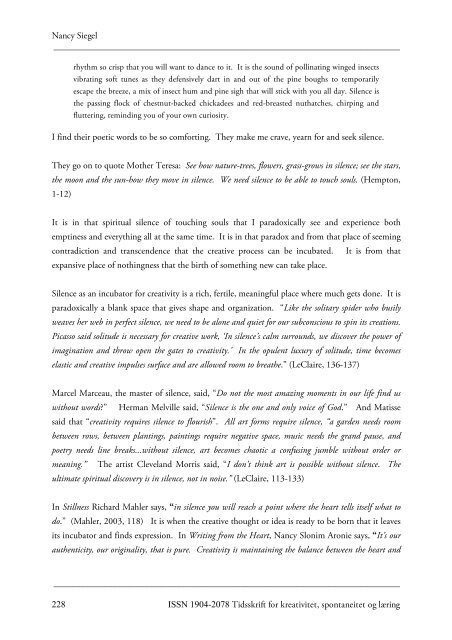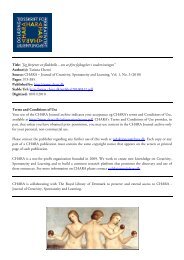VOL 2 Indholdsfortegnelse - Chara - Tidsskrift for kreativitet ...
VOL 2 Indholdsfortegnelse - Chara - Tidsskrift for kreativitet ...
VOL 2 Indholdsfortegnelse - Chara - Tidsskrift for kreativitet ...
You also want an ePaper? Increase the reach of your titles
YUMPU automatically turns print PDFs into web optimized ePapers that Google loves.
Nancy Siegel<br />
____________________________________________________________________________<br />
rhythm so crisp that you will want to dance to it. It is the sound of pollinating winged insects<br />
vibrating soft tunes as they defensively dart in and out of the pine boughs to temporarily<br />
escape the breeze, a mix of insect hum and pine sigh that will stick with you all day. Silence is<br />
the passing flock of chestnut-backed chickadees and red-breasted nuthatches, chirping and<br />
fluttering, reminding you of your own curiosity.<br />
I find their poetic words to be so com<strong>for</strong>ting. They make me crave, yearn <strong>for</strong> and seek silence.<br />
They go on to quote Mother Teresa: See how nature-trees, flowers, grass-grows in silence; see the stars,<br />
the moon and the sun-how they move in silence. We need silence to be able to touch souls. (Hempton,<br />
1-12)<br />
It is in that spiritual silence of touching souls that I paradoxically see and experience both<br />
emptiness and everything all at the same time. It is in that paradox and from that place of seeming<br />
contradiction and transcendence that the creative process can be incubated. It is from that<br />
expansive place of nothingness that the birth of something new can take place.<br />
Silence as an incubator <strong>for</strong> creativity is a rich, fertile, meaningful place where much gets done. It is<br />
paradoxically a blank space that gives shape and organization. “Like the solitary spider who busily<br />
weaves her web in perfect silence, we need to be alone and quiet <strong>for</strong> our subconscious to spin its creations.<br />
Picasso said solitude is necessary <strong>for</strong> creative work, ‘In silence’s calm surrounds, we discover the power of<br />
imagination and throw open the gates to creativity.’ In the opulent luxury of solitude, time becomes<br />
elastic and creative impulses surface and are allowed room to breathe.” (LeClaire, 136-137)<br />
Marcel Marceau, the master of silence, said, “Do not the most amazing moments in our life find us<br />
without words?” Herman Melville said, “Silence is the one and only voice of God.” And Matisse<br />
said that “creativity requires silence to flourish”. All art <strong>for</strong>ms require silence, “a garden needs room<br />
between rows, between plantings, paintings require negative space, music needs the grand pause, and<br />
poetry needs line breaks...without silence, art becomes chaotic a confusing jumble without order or<br />
meaning.” The artist Cleveland Morris said, “I don’t think art is possible without silence. The<br />
ultimate spiritual discovery is in silence, not in noise.” (LeClaire, 113-133)<br />
In Stillness Richard Mahler says, “in silence you will reach a point where the heart tells itself what to<br />
do.” (Mahler, 2003, 118) It is when the creative thought or idea is ready to be born that it leaves<br />
its incubator and finds expression. In Writing from the Heart, Nancy Slonim Aronie says, “It’s our<br />
authenticity, our originality, that is pure. Creativity is maintaining the balance between the heart and<br />
____________________________________________________________________________<br />
228 ISSN 1904-2078 <strong>Tidsskrift</strong> <strong>for</strong> <strong>kreativitet</strong>, spontaneitet og læring



